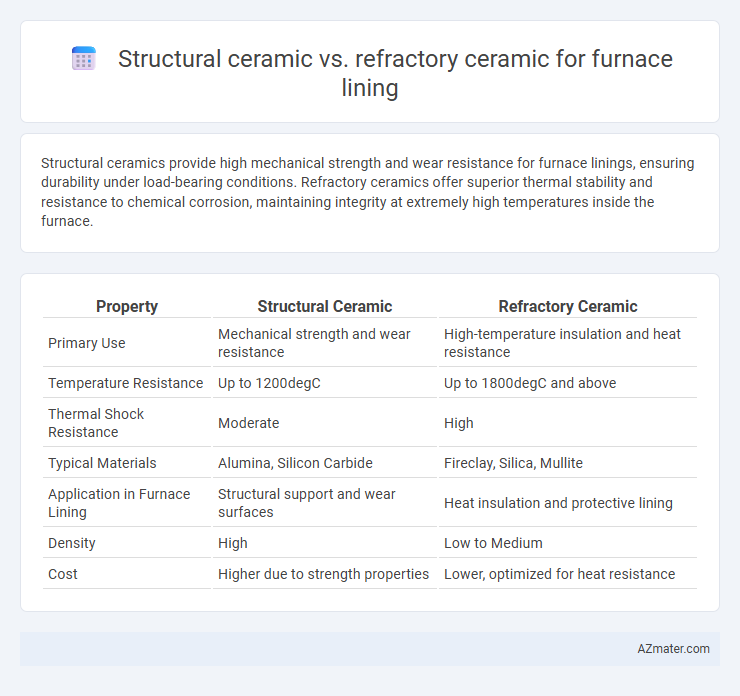Structural ceramics provide high mechanical strength and wear resistance for furnace linings, ensuring durability under load-bearing conditions. Refractory ceramics offer superior thermal stability and resistance to chemical corrosion, maintaining integrity at extremely high temperatures inside the furnace.
Table of Comparison
| Property | Structural Ceramic | Refractory Ceramic |
|---|---|---|
| Primary Use | Mechanical strength and wear resistance | High-temperature insulation and heat resistance |
| Temperature Resistance | Up to 1200degC | Up to 1800degC and above |
| Thermal Shock Resistance | Moderate | High |
| Typical Materials | Alumina, Silicon Carbide | Fireclay, Silica, Mullite |
| Application in Furnace Lining | Structural support and wear surfaces | Heat insulation and protective lining |
| Density | High | Low to Medium |
| Cost | Higher due to strength properties | Lower, optimized for heat resistance |
Introduction to Structural and Refractory Ceramics
Structural ceramics are designed for mechanical strength, durability, and resistance to wear, often used in load-bearing parts of furnace linings, while refractory ceramics provide exceptional thermal stability and resistance to high temperatures, essential for furnace environments exposed to extreme heat. Structural ceramics typically include materials like alumina and silicon carbide, which maintain integrity under mechanical stress, whereas refractory ceramics often consist of fireclay, magnesite, and zirconia for insulating against thermal shock and chemical corrosion. Understanding the distinct roles of structural and refractory ceramics is critical for optimizing furnace lining performance, balancing mechanical support with thermal insulation and longevity.
Key Differences: Structural vs. Refractory Ceramics
Structural ceramics for furnace lining prioritize mechanical strength and load-bearing capacity, making them ideal for parts subjected to high stress and wear. Refractory ceramics excel in thermal resistance and chemical stability at extremely high temperatures, ensuring durability in harsh furnace environments. Key differences include structural ceramics' emphasis on toughness and fracture resistance, while refractory ceramics focus on withstanding thermal shock and corrosive atmospheres.
Material Composition and Properties Comparison
Structural ceramics for furnace lining primarily consist of aluminum oxide (Al2O3), silicon carbide (SiC), and zirconia (ZrO2), offering high mechanical strength, wear resistance, and thermal shock resistance. Refractory ceramics are typically composed of fireclay, alumina, silica, or magnesia, designed to withstand extreme temperatures, chemical corrosion, and thermal deformation over prolonged exposure. The key differences lie in structural ceramics' superior fracture toughness and thermal conductivity, whereas refractory ceramics excel in thermal insulation and resistance to slag corrosion at temperatures often exceeding 1700degC.
Mechanical Strength and Durability in Furnace Environments
Structural ceramics used in furnace linings exhibit high mechanical strength, maintaining integrity under mechanical stresses and thermal shocks. Refractory ceramics offer superior durability by resisting chemical corrosion, thermal degradation, and prolonged exposure to extreme temperatures in furnace environments. The combination of mechanical strength in structural ceramics and the enhanced thermal and chemical stability of refractory ceramics determines optimal furnace lining performance.
Thermal Resistance and Heat Management
Structural ceramics for furnace lining offer high mechanical strength and moderate thermal resistance, making them suitable for components subjected to mechanical stress at elevated temperatures. Refractory ceramics excel in thermal resistance, withstanding temperatures above 1600degC and providing superior insulation to minimize heat loss and improve energy efficiency in furnace operations. Effective heat management in furnace lining is achieved by selecting refractory ceramics with low thermal conductivity and high thermal shock resistance, ensuring durability and consistent thermal performance under cyclic heating conditions.
Chemical Stability and Corrosion Resistance
Structural ceramics for furnace lining exhibit superior chemical stability due to their dense microstructure, which minimizes reactions with aggressive furnace atmospheres. Refractory ceramics offer enhanced corrosion resistance, as their compositions, often rich in alumina or magnesia, withstand molten slags and alkali vapors without significant degradation. Optimizing furnace lining materials requires balancing the inherent chemical stability of structural ceramics with the refractory ceramics' robust corrosion resistance under high-temperature conditions.
Application Suitability for Furnace Lining
Structural ceramics are ideal for furnace lining applications requiring high mechanical strength and thermal shock resistance, especially in environments with moderate temperatures and stress. Refractory ceramics excel in high-temperature furnace linings due to their superior resistance to chemical attack, thermal stability, and ability to withstand extreme heat for prolonged periods. Selecting between structural and refractory ceramics depends on the furnace's operational temperature, chemical atmosphere, and mechanical load demands.
Lifespan and Maintenance Requirements
Structural ceramics used in furnace linings offer superior mechanical strength and thermal shock resistance, resulting in extended lifespan under cyclic loading conditions. Refractory ceramics excel in high-temperature stability and chemical resistance, minimizing degradation but often require more frequent maintenance due to their brittleness and potential for thermal spalling. Choosing between structural and refractory ceramics depends on balancing durability demands with maintenance capabilities, where structural ceramics typically demand less frequent upkeep and provide longer service life.
Cost-Benefit Analysis for Industrial Furnaces
Structural ceramics in furnace linings offer high mechanical strength and thermal shock resistance, making them suitable for load-bearing applications but often come with higher material and installation costs. Refractory ceramics provide superior chemical stability and thermal insulation at elevated temperatures, typically presenting lower upfront costs and improved energy efficiency, which can reduce operational expenses over time. A cost-benefit analysis for industrial furnaces must weigh the higher initial investment in structural ceramics against the long-term savings from enhanced durability and reduced maintenance, while refractory ceramics may optimize immediate cost savings with potential trade-offs in lifespan and mechanical performance.
Choosing the Optimal Ceramic for Furnace Lining
Structural ceramics exhibit high mechanical strength and thermal shock resistance, making them suitable for load-bearing furnace linings that endure dynamic stresses. Refractory ceramics possess superior thermal insulation and chemical stability at extreme temperatures, ideal for protecting furnace shells from molten materials and corrosive atmospheres. Selecting the optimal ceramic depends on balancing mechanical durability and thermal insulation requirements specific to furnace operating conditions and lifecycle expectations.

Infographic: Structural ceramic vs Refractory ceramic for Furnace lining
 azmater.com
azmater.com